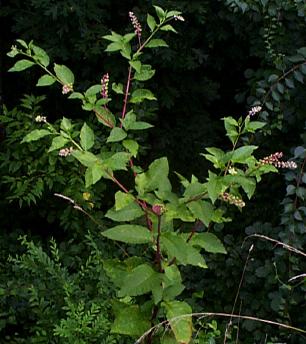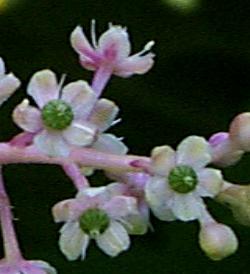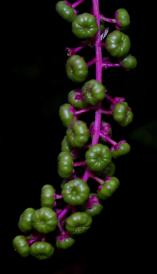 Pretty prevalent -
considered a weed by some.
Pretty prevalent -
considered a weed by some.
|
FAMILY:
Pokeweed Family (Phytolaccaceae)
DESCRIPTION:
A tall, big-leaved plant with magenta
stems and conical clusters of small white flowers.
Leave are 5 - 12" long and elliptic, tapering at
both ends. Flowers are 1/4" wide without petals.
FLOWERS:
July to September (Fruit: September
to August)
HABITAT:
Edges of rich woods, clearing,
roadsides, waste places.
|
|
OTHER INFORMATION:
Poke is an easy plant to identify,
especially later in the season. It's vivid magenta
stems towering 10-12 feet high are frequent
roadside visitors. These stems are hollow affairs
punctuated by tough membranes, making a series of
hollow chambers, no doubt for support, as late in
autumn many groups have fallen over under the
weight of a huge amount of deep voilet, almost
black berries. The flowers, composed of 5 white
petal-like appendages, already seem to have a green
hard berry inside, ready to inflate. Once these
berries ripen, they are filled with a bright pink
juice that stains the skin, like a deep birthmark.
I confess, for fun, i've painted my whole hand and
arm with poke, and it doesn't take many berries to
do this. It only lasts thru 2 or 3 bathings,
however. I seemed to have no ill effects, other
than askance looks and comments, and some books
indicate that it was used like this by indians.
|
|

|
|
|

A
close-up of the actual flowers show that
even without true petals, a flower can be
attractive.
|

|
|
|
|
POKE SALLET
Poke, when picked April and May and up to 8"
tall - before the leaves toughen and get more
poisonous - is a great early spring leafy green.
"Sallet" is both an Old English and Mountain
Hill-folk word meaning "cooked greens", (Just like
the word "Victuals" and "Vittles") and is NOT the
same as "salad" which implies uncooked. Poke, even
when young and tender - and any reddish part of the
root cut away - needs to be boiled for 20-30
minutes, with at least 2 changes of boiling water
at a minute each. The resulting greens are like a
sort of wild-tasting asparagus and should be eaten
that way. Some people have said they then pickle
the shoots in hot vinegar, but i've not tried this.
Anyway, it is rich in minerals and vitamins, and a
tasty reprieve from hard store-bought greens.
|
![]()
![]()
![]()
![]()
![]()